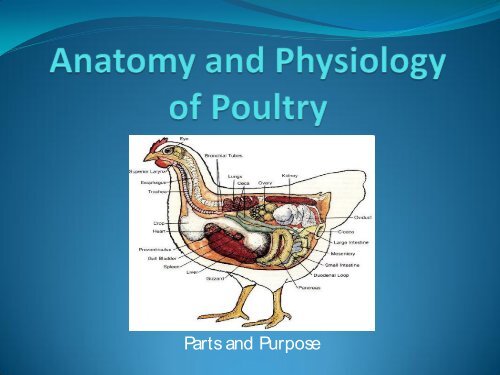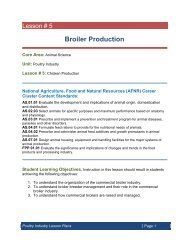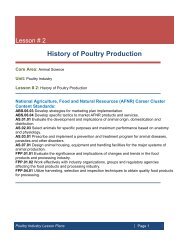Anatomy and Physiology of Poultry - U.S. Poultry and Egg Association
Anatomy and Physiology of Poultry - U.S. Poultry and Egg Association
Anatomy and Physiology of Poultry - U.S. Poultry and Egg Association
Create successful ePaper yourself
Turn your PDF publications into a flip-book with our unique Google optimized e-Paper software.
Parts <strong>and</strong> Purpose
What is different about the bird<br />
compared to mammals?<br />
•Feathers<br />
•Lack teeth<br />
•Lay eggs<br />
•Float <strong>and</strong> fly<br />
•Waste excreted from only<br />
one orifice
What is <strong>Anatomy</strong>?<br />
• <strong>Anatomy</strong>: the science <strong>of</strong> the<br />
structure <strong>of</strong> animals.<br />
• Derived from the Greek<br />
work “to cut up.”
What is <strong>Physiology</strong>?<br />
• <strong>Physiology</strong>: the science that<br />
deals with the functions <strong>of</strong><br />
the living organism <strong>and</strong> its<br />
parts.
Anatomical Terms<br />
• The following terms are used to describe locations on<br />
the animal body.<br />
• Dorsal: pertains to the upper surface <strong>of</strong> the animal.<br />
• Ventral: relates to the lower <strong>and</strong> abdominal surface.<br />
• Cranial (or anterior): applies to the front or head.<br />
• Caudal (or posterior): pertains to the tail or rear.
Anatomical Directional Terms
Body Systems <strong>of</strong> <strong>Poultry</strong><br />
• Integumentary<br />
• Respiratory<br />
• Skeletal<br />
• Digestive<br />
• Circulatory<br />
• Urinary<br />
• Reproductive
Integumentary System<br />
• The skin, feathers, <strong>and</strong> beak.<br />
• Function: to protect the bird from external harm.<br />
• Skin<br />
• Much like humans, with the exception <strong>of</strong> plumage production.<br />
• Plumage: the outer covering <strong>of</strong> a bird’s body.<br />
• Feathers, scales, filoplumes.<br />
• Filoplumes: hair-like structures located at the base <strong>of</strong> feathers.<br />
• Wattle: a red growth underneath the beak, which works in<br />
conjunction with the comb, an excess <strong>of</strong> skin on top <strong>of</strong> their head.<br />
• Function: circulation <strong>of</strong> blood between the two regulate the temperature<br />
<strong>of</strong> the bird.<br />
• The size <strong>of</strong> the comb is an indication <strong>of</strong> the levels <strong>of</strong> testosterone in the<br />
body. If the comb is large, then this means more testosterone is present,<br />
<strong>of</strong>ten meaning the sex <strong>of</strong> the bird is male.
Filoplume<br />
Comb<br />
Beak<br />
Scales<br />
Wattle<br />
Nails<br />
Plumage
Scales <strong>and</strong> Plumage<br />
• Scales are located on the legs <strong>and</strong> feet.<br />
• The plumage is always for altered shape.<br />
• Function: body cooling <strong>and</strong> heating for maintenance <strong>of</strong><br />
body temperature, protects against abrasions <strong>and</strong> bruises<br />
when birds are in groups or lying on the ground.<br />
• Plumage shape is particularly important for cooling since<br />
birds lack sweat gl<strong>and</strong>s.<br />
• Although it is not common for production birds to fly,<br />
plumage type <strong>and</strong> form is an important determinant in<br />
flight for aerial species.
Beaks vs. Lips <strong>and</strong> Teeth<br />
• Birds have beaks as opposed to lips <strong>and</strong> teeth.<br />
• The beak is used for eating <strong>and</strong> drinking, as well as in<br />
self-defense <strong>and</strong> protection from other animals.<br />
http://www.youtube.com/watch?v=ir81HfA6A0I
Respiratory System<br />
• Vastly different than the mammalian respiratory<br />
system.<br />
• Unlike mammals, birds lack a diaphragm to inflate<br />
<strong>and</strong> deflate the lungs.<br />
• Instead, birds have nine air sacs located in the neck<br />
region <strong>and</strong> body cavity that function to inflate the lungs.<br />
• Gas exchange occurs in the Avian lung <strong>and</strong> the air sacs<br />
function to move air in <strong>and</strong> out <strong>of</strong> the respiratory system.
Heart<br />
Air sac membrane<br />
Air sac cavity<br />
Liver<br />
Cut ribs
• Breathing process has two phases: inhalation <strong>and</strong><br />
exhalation.<br />
• Inhalation: when the bird breathes in, air bypasses the lungs<br />
<strong>and</strong> enters the posterior air sacs. At the same time, air in the<br />
lungs from the last exhalation phase exits the lungs <strong>and</strong><br />
enters the anterior air sacs.<br />
• Exhalation: the bird releases air from the posterior air sacs,<br />
which enters the lungs. The air that filled the anterior air sacs<br />
from the inhalation phase is then released from the body<br />
through the trachea.<br />
• Nares are the nostrils located on the beak. Their<br />
purpose is the passageway for air to be breathed in <strong>and</strong><br />
out <strong>of</strong> the trachea.<br />
http://www.youtube.com/watch?v=LbJU0ocOKdo
Nares
Skeletal System<br />
1. Pneumatic Bones<br />
• <strong>Poultry</strong> have pneumatic, or hollow, bones.<br />
• Connect with the respiratory system.<br />
• Their light weight is an adaptation for flight.<br />
2. Medullary Bone<br />
• Medullary bone contains high amounts <strong>of</strong> calcium.<br />
• Storage source is used by the female hen to produce the egg shell<br />
during reproductive periods.<br />
3. Fused Bones<br />
• Bones in the foot, or shank, are fused.<br />
• Cause birds to walk upright.<br />
• Many vertebrate along the backbone are fused for the purpose <strong>of</strong><br />
flight.
Digestive<br />
System<br />
The University <strong>of</strong> Arizona: species info. Chickens <strong>and</strong> Turkeys<br />
2008
Parts <strong>of</strong> the Mouth<br />
• Tongue<br />
• Beak<br />
• Taste buds<br />
Beak
Esophagus<br />
• Flexible tube that connects mouth to the crop.
Crop<br />
• Function: moisten <strong>and</strong> temporary storage <strong>of</strong> food<br />
CROP
This is a picture <strong>of</strong> <strong>and</strong> opened crop. Notice the yellow feed<br />
pellets that have been moistened while they were stored in<br />
this chicken’s crop.<br />
Cranial<br />
Pectoralis<br />
muscle<br />
Crop
Proventriculus<br />
• The stomach <strong>of</strong> the bird.<br />
• Function: uses acids <strong>and</strong> digestive enzymes to<br />
breakdown food.<br />
Proventriculus
Gizzard<br />
• Function: like “teeth,” it mechanically grinds up food<br />
particles.<br />
Gizzard
These pictures show a gizzard that has been opened.<br />
Notice how the feed inside it has been further<br />
digested.
Small Intestines<br />
• Three sections:<br />
- Duodenum<br />
- Ileum<br />
- Jejunum<br />
Function: absorption <strong>of</strong><br />
nutrients from food.<br />
Small Intestines
Ceca<br />
• Two ceca that are terminal pouches.<br />
• Function: fermentation <strong>of</strong> any left over food particles/<br />
water absorption.<br />
Ceca
Colon<br />
• A.K.A. Large intestine<br />
• Function: Further water absorption<br />
Large Intestine
Cloaca<br />
• Also known as the vestibule.<br />
• Function: responsible for expulsion <strong>of</strong> feces <strong>and</strong> urine<br />
through the vent.<br />
Cloaca
Liver<br />
• Multi-lobed organ<br />
• Functions:<br />
- produce bile to digest fats (stored in gall<br />
bladder).<br />
- detoxification<br />
- store fat <strong>and</strong> fat-soluble vitamins (i.e., A,D,E, K)<br />
- metabolize fats, carbohydrates, <strong>and</strong> proteins that<br />
are in the diet.
LIVER<br />
GALL BLADDER
Pancreas<br />
• Function: Produces insulin, useful in carbohydrate<br />
digestion.<br />
Pancreas
Circulatory System<br />
Department <strong>of</strong> Biological Sciences. Eastern Kentucky University BIO 554<br />
Ornithology
Heart<br />
The heart pumps blood throughout the body to deliver<br />
oxygen <strong>and</strong> nutrients to tissues <strong>and</strong> to remove carbon<br />
dioxide <strong>and</strong> metabolic waste from tissues.<br />
Heart
Blood Vessels<br />
• Arteries: carries blood from heart & to the rest <strong>of</strong> the<br />
body.<br />
• Arterioles: directs blood to certain tissues <strong>of</strong> the body.<br />
• Capillaries: site <strong>of</strong> exchange between blood <strong>and</strong><br />
tissues.<br />
• Veins: brings oxygenated blood back to the heart.
Blood<br />
• Components <strong>of</strong> Blood:<br />
- Red Blood Cells (erythrocyte)<br />
- White Blood Cells (leukocyte)<br />
- Plasma<br />
Red Blood<br />
Cell<br />
White<br />
Blood Cell
Urinary System<br />
• A. Kidneys<br />
• Two multi-lobular structures located in the rib cage.<br />
• Produce urine by removing waste products from the blood.<br />
• B. Ureters<br />
• Transports the liquids kidney filtrate from the kidneys to the<br />
cloaca for excretion.<br />
• Birds do not have a bladder.<br />
• Urine is not stored, but rather excreted when produced.<br />
• C. Cloaca<br />
• Feces <strong>and</strong> urine exit out <strong>of</strong> the bird’s body through this region in<br />
the abdominal cavity.<br />
• D. Uric Acid Excretion<br />
• <strong>Poultry</strong> excreta contain uric acid.<br />
• Very high in nitrogen due to its lowered water content is semi-solid.
Male Reproductive System<br />
1. Two testes located internally in the body.<br />
2. Ductus Deferens<br />
• Deliver semen from the testes to the phallus.<br />
3. Rudimentary phallus<br />
• <strong>Poultry</strong> have no external penis, but rather an internal<br />
protuberance termed a rudimentary phallus.
Female Reproductive System<br />
1. Ovary<br />
-<strong>Poultry</strong> have only one functioning ovary, usually the left ovary.<br />
2. Oviduct<br />
a. Function: to produce albumen (egg white), shell membrane, <strong>and</strong> the<br />
shell around the yolk.<br />
b. Five regions<br />
1. Infundibulum: receives the follicle <strong>and</strong> is the location <strong>of</strong> conception<br />
where the male <strong>and</strong> female gamete come together.<br />
2. Magnum: produces the albumen.<br />
3. Isthmus: produces the inner <strong>and</strong> outer shell membranes.<br />
4. Uterus: plumps the egg, forms the shell <strong>and</strong> cuticle (seals pores <strong>of</strong><br />
the egg shell) <strong>and</strong> determines the shell pigment.<br />
5. Vagina: produces some cuticle, <strong>and</strong> expels the egg <strong>and</strong> regulates<br />
timing <strong>of</strong> egg production.
Female Reproductive System<br />
3. Cloaca<br />
- Also known as the vestibule. The common chamber through which the<br />
egg passes is also responsible for the expulsion <strong>of</strong> feces <strong>and</strong> urine.<br />
4. Vent<br />
- the exterior opening through which passage occurs from the digestive<br />
system, the urinary tract <strong>and</strong> the reproductive tract.<br />
5. Ovulation<br />
- The releasing <strong>of</strong> the egg yolk from the ovary to begin its journey through<br />
the oviduct.<br />
6. Oviposition -the process <strong>of</strong> laying the fully formed egg which is regulated<br />
by hormones.
Don’t be chicken…








